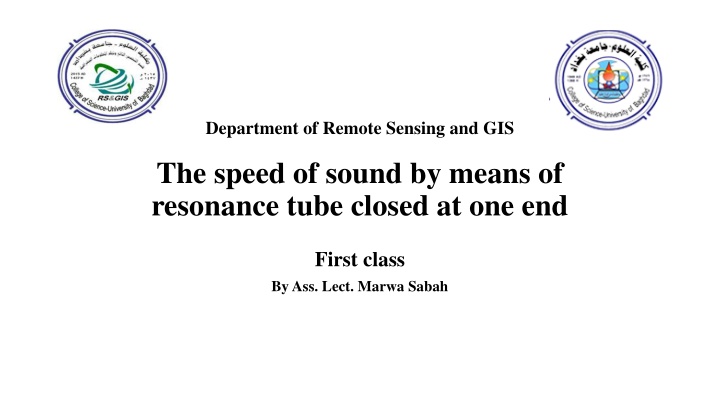
Determination of Speed of Sound: Resonance Tube Experiment
Explore the process of determining the speed of sound using a resonance tube experiment with tuning forks and a thermometer. Understand the theory, procedure, and calculation methods involved in this hands-on experiment.
Download Presentation

Please find below an Image/Link to download the presentation.
The content on the website is provided AS IS for your information and personal use only. It may not be sold, licensed, or shared on other websites without obtaining consent from the author. If you encounter any issues during the download, it is possible that the publisher has removed the file from their server.
You are allowed to download the files provided on this website for personal or commercial use, subject to the condition that they are used lawfully. All files are the property of their respective owners.
The content on the website is provided AS IS for your information and personal use only. It may not be sold, licensed, or shared on other websites without obtaining consent from the author.
E N D
Presentation Transcript
Department of Remote Sensing and GIS The speed of sound by means of resonance tube closed at one end First class By Ass. Lect. Marwa Sabah
The purpose from experiment: Determination of the speed of sound by means of resonance tube closed at one end. Used devices: Resonance tube about 100cm long and 3 cm in diameter, set of tuning forks, meter ruler, thermometer.
frequency: The number of waves emitted by an object per second. If two objects with the same frequency are placed near each other, and vibration is caused in one of them, the second will be affected by the first and vibrate with the same frequency, this phenomenon known the Resonance
Theory: L1 + e = . (1) L2 + e = 3/4 .. .. (2) Where ( ) is the wave length Hence by subtraction L1 L2 = /2 ..(3)
Now if (C) is the speed of sound, and (f) the frequency of the note, we have : C = f .(4) Hence from (3) and (4) C = 2 f (L2 L1) .(5) The value of the end correction for the tube can be calculated from (1) and (2) above which given by: (L2 + e)/ (L1 + e) = 3 or e = (L2 3L1) Compare your final mean value for (C) with that calculated from the formula
(???+?) ??? C = 331 meters per second Where (t): is the temperature in C .
Procedure: Place the resonance tube well down in the water and gradually raised.
Select the fork of highest frequency, strike it on a solid surface and hold it over the mouth of the tube and when resonance occurs (i.e. when the note of the fork swells out to its loudest volume). Measure the length of the air in the tube which is the distance between the mouth of the tube and the water surface. Now find a second and different position of resonance using the same fork but with a much longer length of air and again take the value of (L2) Obtain different values of (L1) and (L2) by using the other forks. Record the results in the form of a table: Plot a graph between ( ) on a vertical axis and (1/f) on a horizontal axis.
